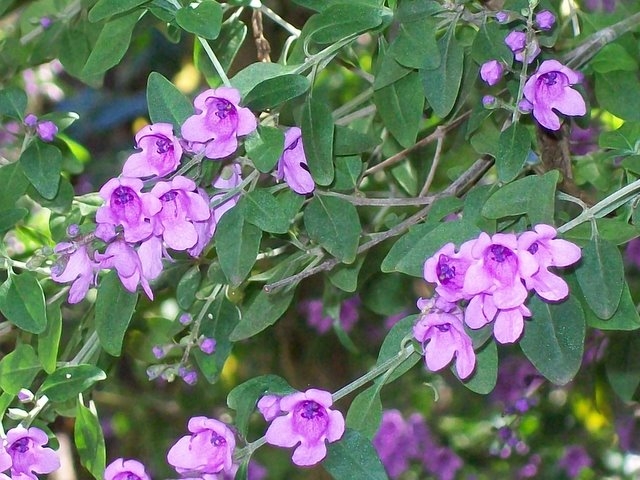Purple Mintbush
(Prostanthera ovalifolia)
Purple Mintbush (Prostanthera ovalifolia)
/
/

Poyt448 Peter Woodard
CC0
Image By:
Poyt448 Peter Woodard
Recorded By:
Copyright:
CC0
Copyright Notice:
Photo by: Poyt448 Peter Woodard | License Type: CC0 | License URL: http://creativecommons.org/publicdomain/zero/1.0/deed.en | Uploader: Poyt448 | Publisher: Wikimedia Commons | Title: Prostanthera_ovalifolia_Eastwood.jpg | Notes: A protea flower {{Fir0002 20D}} |
















Estimated Native Range
Summary
Prostanthera ovalifolia, commonly known as Purple Mintbush, is an evergreen shrub native to the understory of dry sclerophyll forests and woodland areas in Eastern Australia. It is characterized by its erect habit and egg-shaped leaves, which are aromatic when crushed. The Purple Mintbush typically grows to a height of 1–4 m (3 ft 3 in – 13 ft 1 in) and has stems that are square in cross-section and moderately hairy. The leaves are arranged opposite each other along the stems, adding to the dense appearance of the shrub. The flowers are a standout feature, with their mauve to deep blue-purple petals fused into a tube 6–18 mm (0.24–0.71 in) long, and are arranged in groups at the ends of branchlets. Flowering occurs from late winter to early summer (August to November), and the flowers are highly attractive to bees and other pollinators.
Purple Mintbush is valued for its vibrant flowers and aromatic foliage, making it a popular choice for ornamental gardens. It is often used in border planting, as a feature shrub, and for aromatic gardens. The plant is relatively easy to maintain, requiring pruning back by about one-third annually to retain its bushy shape and promote vigorous growth. It thrives in well-drained soils, prefers some protection from the harsh afternoon sun, and requires medium amounts of water. While it does best in full sun to part shade, it can tolerate a range of soil types, provided they have good drainage. Purple Mintbush is not known for having significant disease problems, but it can be affected by root rot if planted in poorly drained soils.CC BY-SA 4.0
Purple Mintbush is valued for its vibrant flowers and aromatic foliage, making it a popular choice for ornamental gardens. It is often used in border planting, as a feature shrub, and for aromatic gardens. The plant is relatively easy to maintain, requiring pruning back by about one-third annually to retain its bushy shape and promote vigorous growth. It thrives in well-drained soils, prefers some protection from the harsh afternoon sun, and requires medium amounts of water. While it does best in full sun to part shade, it can tolerate a range of soil types, provided they have good drainage. Purple Mintbush is not known for having significant disease problems, but it can be affected by root rot if planted in poorly drained soils.CC BY-SA 4.0
Plant Description
- Plant Type: Shrub
- Height: 4-6 feet
- Width: 3-5 feet
- Growth Rate: Moderate, Rapid
- Flower Color: Purple
- Flowering Season: Spring
- Leaf Retention: Evergreen
Growth Requirements
- Sun: Full Sun
- Water: Medium
- Drainage: Medium, Fast
Common Uses
Bee Garden, Bird Garden, Border Plant, Butterfly Garden, Fragrant, Hedges, Hummingbird Garden, Low Maintenance, Showy Flowers, Street Planting
Natural Habitat
Native to the understory of dry sclerophyll forests and woodland areas in Eastern Australia
Other Names
Common Names: Mintbush, Oval-Leaf Mintbush
Scientific Names: , Prostanthera ovalifolia, Prostanthera latifolia, Prostanthera atriplicifolia, Prostanthera ovalifolia var. latifolia,
GBIF Accepted Name: Prostanthera ovalifolia R.Br.